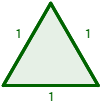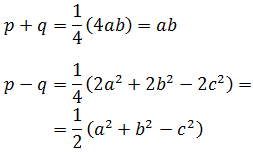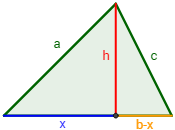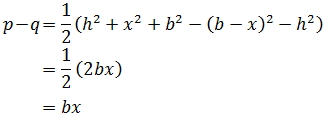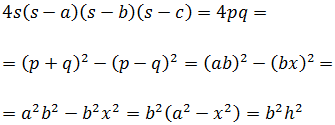Heron of Alexandria |
Content of this page:
-
Heron of Alexandria Biography
-
Heron's Formula (proved by using the Pythagorean Theorem)
-
Heron's Method (approximation of the square root of a number):
-
3.1. The Method and some Examples
-
3.2. A Proof of the Convergence
-
1. Heron of Alexandria Biography
Heron of Alexandria (or Hero of Alexandria) lived in Alexandria (currently the North of Egypt) around the centuries I and II B.C.E. He was a mathematician and engyneer, and invented the first steam engine, which was known as aeolipile (or aeolipyle, or eolipile). In this way, most of the Heron's original writings deal with mathematics and mechanics.
Metrica is a writing divided into three parts where Hero gives formulas and quite rigorous methods to calculate areas of regular polygons, triangles, quadrilaterals and ellipses, as well as the volume of spheres, cylinders and cones.
In this work, Heron states the formula known now as Heron's Formula, which we explain below. We will also use the Heron's Method to approximate square roots of natural numbers. This technique is still used in computer science.
2. Heron's Formula
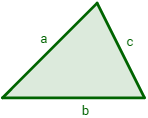
The area of the triangle with sides a, b and c is
$$ Area = \sqrt{s\cdot (s-a) \cdot (s-b) \cdot (s-c)}$$
where s is the semiperimeter of the triangle:

3. Heron's Method
Heron’s Method is about calculating the members of the sequence defined by recursion

where p is the number whose square root we want to approximate.
The first term, x0, has to be an approximation to the square root we are looking for.
3.1. The Method and some Examples
Heron’s Method converges fastly: reasonable approximations (with a few of exact decimals) are obtained with a few of iterations, even if the x0 chosen is very different from the number we want to approximate. Moreover, the implementation of this method is very simple (see the MatLab function).
Let us put the example of the approximation of the square root of 3,
$$ \sqrt{3} \simeq 1.732050807568877 $$
We start with x0 = 1, x0 = 2 and x0 = 100. There will be 10 iterations:
For x0 = 1:
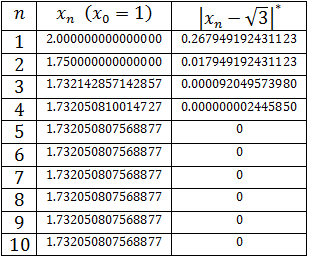
*Note: since the error (third column) is obtained by computing, the error is 0 when the precision of the computer is achieved or surpassed.
For x0 = 2:

For x0 = 100:
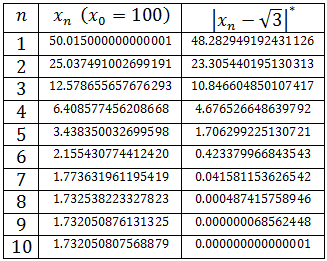
The code we used is:
1 function x=Heron(p,a,n) 2 % approximation of the square root of p 3 % a is the term x_0 4 % n is the number of iterations 5 % x is a column with the format of 6 % the tables above 7 x=zeros(n,2); 8 x0=a; 9 x(1,1)=0.5*(x0+p/x0); 10 x(1,2)=abs(x(1,1)-sqrt(p)); 11 for i = 2:n 12 x(i,1)=0.5*(x(i-1)+p/x(i-1)); 13 x(i,2)=abs(x(i,1)-sqrt(p)); 14 end 15 end
3.2. Proof of the convergence
We are going to prove that, in fact, the sequence

converges to the square root of p.
We will apply the Monotone convergence theorem:
Theorem: Let xn be a sequence, decreasing and bounded from below. Then, its infimum is the limit:

We need to prove that
-
the sequence is bounded from below, and
-
it is monotonic decreasing.
a) The sequence is bounded from below by the square root of p:
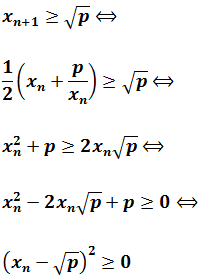
Since the last inequation always holds, the former one so.
b) The sequence is monotonic decreasing:

By a), the last inequality is true. Therefore, the former one also holds.
Finally, by applying the Monotone convergence theorem, the sequence converges to the square root of p:


Matesfacil.com
by J. Llopis is licensed under a
Creative
Commons Attribution-NonCommercial 4.0 International License.

